FINAL REPORT: Sustainable Intensification of Dual-Purpose Cowpea Varieties for Enhanced Food and Fodder in Senegal
July 2, 2024
Feed the Future Innovation Lab for Legume Systems Research
Final Report
Project Title: Sustainable Intensification of Dual-Purpose Cowpea Varieties for Enhanced Food and Fodder in Senegal
Executive Summary
Our goal was to evaluate agronomic management strategies for sustainable intensification and integration of dual-purpose cowpea (greater grain and fodder quantity and quality on the same land area) into farming systems across the peanut basin in Senegal. We conducted genotype × environment × management and cowpea variety studies across three ecological regions (Louga, Diourbel, and Kaffrine) covering annual rainfall gradient of 350-750 mm in Senegal. Results showed fertilizer application increased cowpea grain yield by 48% in Bambey, 27% in Boulel and 34% in Darou Mousty. Fodder yields increased by 8% in Bambey, 39% in Boulel and 31% in Darou Mousty. Based on net revenue from grain and fodder sales using partial budget analysis, the best dual-purpose cowpea varieties across locations were Leona, Melakh, Theiye, Kelle, Sam, Pakaw, and E-BC4STR1 (sourced from USA).
The cooking time of the newly released varieties Leona (39 min), Pakaw (41 min), Lizard (43 min) or Sam (47 min) were not different from older variety Yacine (42 min). The grain protein concentration of Leona (24%), Thieye (24%), Kelle (26%), Lizard (25%), and Sam (23%) were greater than Yacine (22%). Iron concentration in Thieye, Kelle, Lizard, and Sam were greater than Yacine, but Zn was similar among the cowpea varieties.
Applying fertilizer in combination with farmyard manure significantly increased grain and fodder yields compared with fertilizer alone. Combining manure with fertilizer application in 2021 had no effect on cowpea yields in Louga but increased fodder and grain yields by 18-42% in Dioubel and 24-51% in Kaffrine. In 2022, manure plus fertilizer application increased cowpea fodder and grain yields by 21-43% in Dioubel, 78-84% in Kaffrine and 66-53% in Louga region. This suggests environment and soil factors have significant effect on cowpea productivity and fertilizer use efficiency.
Across 150 producer farms, cowpea grain yield was 562 kg/ha with Leona, 527 kg/ha with Thieye and 385 kg/ha for Yacine. Fodder yields averaged 1414 kg/ha for Leona or 1354 kg/ha for Thieye and 1061 kg/ha for Yacine. Farmer surveys conducted in 2021 showed adoption of dual-purpose cowpea was 20% among farmers in Louga, 32% in Kaffrine and 48% in Bambey. Reasons for adoption varied and includedaccess to information, proximity to research facility, producer preference, and uses of cowpea grain and fodder. Socioeconomic survey results in 2023 showed 47% of producers who participated in the on-farm dual-purpose cowpea trials have changed their production practices, 3% had increased the amount of labor use and 48% have cultivated new land. Approximately 30% of farmers indicated using dual-purpose varieties increased cowpea seed yields while 58% said they obtained more fodder yield, and 51% of beneficiaries indicated their standard of living has improved through the sales of fodder from dual-purpose cowpea varieties. Furthermore, our findings showed crop sales (mostly cowpea and millet) accounted for 87% of household income compared to 2.9% for livestock. These findings are significant and showed adopting dual-purpose cowpea varieties by farmers in these regions will improve household income (grain and fodder sales) resilience, nutrition, and food security of Senegalese smallholder farmers.
Project Partners
This research was a collaborative effort among scientists at Kansas State University (KSU) and Senegalese National Agricultural Research and Extension Services (NARES) (i.e., ISRA and ANCAR), building on past research, existing collaborations, and leveraging resources from previous USAID funded projects.
Project participants included:
Lead PI:
Dr. Augustine K. Obour
Associate Professor of Soil Science, Agricultural Research
Center-Hays, Kansas State University, USA. 1232 240th Avenue, Hays, Kansas 67601 Email:
aobour@ksu.edu, Phone: 785-625-3425 ext. 215
Co-PIs:
Dr. Aliou Faye
Research Scientist in Soil Science, SIIL Country Coordinator, Institut
Senegalais de Recherches Agricoles (ISRA), Bambey, Senegal. Email:
aliouselbe11@gmail.com, Phone: +221-77-568-1342
Dr. Doohong Min
Associate Professor of Forages, Department of Agronomy, Kansas State
University, 1712 Claflin Road, Manhattan, Kansas 66506, USA. Email: dmin@ksu.edu; Phone:
785-532-2292
Bineta Mbengue Dieye
Regional Director of National Agency for Extension and Advising
(ANCAR), Senegal. Email: binoudieye@yahoo.fr, Phone + 221 77 643 94 04
Dr. Mouhamadou Moussa Diangar
Research Scientist in Cowpea Breeder, Institut Senegalais de
Recherches Agricoles (ISRA), Bambey, Senegal. Email: diiangarfils@live.fr, Phone: +221-77-
568-1342
Dr. Lamine Diame
Agricultural Entomologist, Cheikh Anta Diop University of Dakar, Senegal.
Email: diamelamine99@gmail.com
Additional Collaborating Institutions and Personnel:
Sustainable Intensification Innovation Lab
(Project co-PI: Dr. Vara Prasad; Email vara@ksu.edu)
SOILS Consortium
KSU Geospatial Consortium
Dr. Ibrahima Sarr
(Agricultural Entomologist at ISRA - CNRA of Bambey with
expertise in cowpea pests; Email: Ibrahima.sarr@isra.sn)
Project Goals and Objectives
Livestock is an integral part of the farming systems in semi-arid regions of west Africa (mostly agropastoral). Approximately 40% of the total ruminant livestock in SSA are raised in agropastoral systems of the savannas in west Africa. A major constraint in this farming system is limited availability of fodder to support livestock particularly in the dry season. When available, the nutritive value of native rangeland forages is very low. In regions with livestock, cowpea residues are removed as a high value and a tradable commodity in fodder markets to complement residue of cereal crops. Therefore, integrating dual-purpose cowpea cultivars for grain and fodder has the potential to improve quality forage availability for regional livestock productivity. Adoption of dual-purpose cowpea could also help to progressively shift extensive pastoral livestock systems that cause farmer and pastoralist conflicts (due to limited land) to a semi-intensive livestock system of animal fattening or milk production. In Senegal, cowpea is the second highest produced legume behind peanut and plays a strategic role during the lean season (middle of the rainy season and before next harvest) when food stocks are low. Cowpea is also a highly valued forage resource used for domestic livestock production, especially for goat, sheep, and cow fattening for Tabaski and milk production. Substantial research has been conducted to develop dual-purpose (i.e. grain and fodder), nutrient dense, cowpea cultivars (e.g. Lizard, Leona, Kelle, and Sam). The new cultivars have “stay green" properties at maturity for improved fodder quality and are tolerant to heat stress which is ideal for production in the targeted regions of this research. These new cowpea varieties have been available in Senegal only recently and best agronomic management practices and economic performance in traditionally pastoral or cowpea cultivating areas has not been considered. Improved genetics paired with appropriate agronomic management and an understanding of socioeconomic tradeoffs is critical for driving dissemination and adoption by farmers with the goal of improving resilience, nutrition, and food security of Senegalese smallholder farmers.
Sustainably intensifying this system and increasing farmer adoption is intrinsically multidisciplinary and based on minimizing tradeoffs and maximizing synergies across biophysical and socioeconomic domains including productivity, economic, environmental, human, and social domains. This project evaluated agronomic management strategies for the sustainable intensification of dual-purpose cowpea (i.e. increased food and fodder quantity and quality on the same land area) into smallholder, agropastoral farming systems across different agroecological zones in Senegal. We used multidisciplinary, farming systems approach and a participatory research model (i.e., “mother-baby trial”) to collect both robust biophysical farming systems data and socioeconomic data. The specific research objectives of these project were: 1) evaluate the dual benefits of cowpea varieties to increase both grain and fodder quantity and quality and 2) conduct a tradeoff assessment for cowpea markets with particular focus on tradeoffs and synergies between grain and fodder production in areas that are traditionally pastoralists compared to areas that traditionally grow cowpea.
Overview of Research Activities
Objective 1: Evaluate the dual benefits of cowpea varieties to increase both grain and fodder quantity and quality.
The main testable research hypothesis under this objective were 1) dual-purpose cowpea can increase production of both grain and fodder per unit area without incurring a tradeoff, though these parameters will likely be affected by environment, and 2) “stay-green” dual-purpose cowpea cultivars will produce greater fodder and grain quality that have greater fodder and grain quality than traditional cultivars.
We conducted field research from June 2020 to November 2022 to evaluate improved dual-purpose cowpea cultivars and appropriate agronomic management with fodder quality and tradeoff assessments. Experiments were conducted both on-station and on-farm (“mother-baby trials”) to facilitate farmer experimentation and bi-directional learning between researchers and farmers to facilitate adoption of dual-purpose cowpea technology. The mother-baby trial design is a widely accepted methodology for the quantitative analysis of data from participatory
methods (Kamanga, 2001; Snapp, 2002).
I. Mother trials (on-station study):
Genotype × Management × Environment Study (2020 through 2023): Started in 2020 growing season, we have conducted G × E × M studies across three locations in Senegal [Boulel (Kaffrine region (700 -750 mm), Bambey (Diourbel (500 - 550 mm) and Darou Mousty (Louga region (400 - 450 mm), Fig 1] with distinct rainfall gradient. Research efforts have tested 10 cowpea cultivars and differing agronomic management intensities including sole and intercropping and nutrient management regimes.
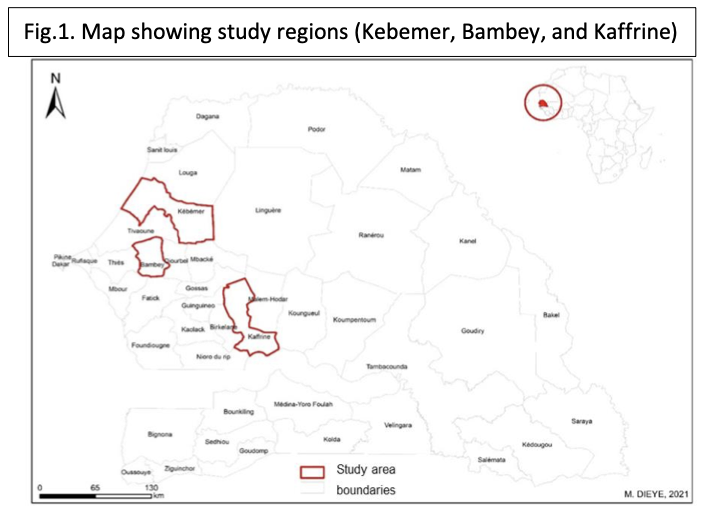
The experimental design was a randomized complete block with split-split-split arrangement of treatments. The main plots were intercropped and sole cowpeas. Subplots were 10 varieties of cowpeas (Kelle, Leona, Lizard, Thieye, Sam, Melakh, Yacine, 58-74F; 66-35F, E-BC4STR1, E-BC4 STR5) and split-split-plots were five fertilizer management treatments (control, 30 kg/ha P2O5/P; 30 kg N/ha-30 kg P2O5/ha-30 kg K2O /ha; 15 kgN/ha-15 P2O5/ha -15 kg K2O; 2.5t/ha manure plus 30 kg N/ha-30 kg P2O5/ha-30 kg K2O /ha).
Cowpea variety and residual nutrient study: Like the G × E × M study, these experiments started in 2020 growing season and field data collection completed in October 2022. The experiment design is a randomized complete block with three replications in a split-plot design with two-fertilizer treatments as main plots (control, 9 kg N/ha; 30 kg P2O5/ha; 15 kg K2O /ha as recommended dose rate) and twenty cowpea varieties as sub-plots. The twenty grain and dual-purpose (both grain and forage) cowpea varieties included five newly released cowpea varieties (Kelle, Leona, Lizard, Thieye, and Sam), and two older varieties as checks (Melakh, Yacine). The other Senegalese varieties included are Ndiambour, Pakaw, Bambey, Mouride, Dongama, and Moungne. Additionally, seven varieties were obtained from University California-Riverside (58-74F; 66-35F, E-BC4STR1, E-BC4 STR5; E-BC4 STR6; E-BC4 STR8, E-BC4 STR 11). Forage yield and quality were determined in each growing season.
In 2020-2021 and 2021-2022 growing seasons, we evaluated prior cowpea residue management effect on grain and biomass yield of millet (Pennisetum glaucum (L.) R. Br) in rotation. This experiment quantified the impacts of the previous cowpea variety, fertilizer application to the previous cowpea crop, and previous cowpea residue management on millet yields. The experimental design for millet component of the study was a randomized complete block with three-factor split-split plot arrangement of treatments with three replications. The two factors are the cowpea varieties and fertilizer treatments prior to millet planting. The third factor superimposed on the cowpea variety study was cowpea residue management after harvest (residue buried or removed). At physiological maturity of cowpeas, seeds of all cowpea varieties were harvested, and yields assessed. Following cowpea seed harvest at physiological maturity, each sub-plot was divided into two sub-sub-plots of 3 m × 5 m (15m2). All the biomass within one of the sub-sub-plots was removed as animal feed (farmers practice) while biomass in the remaining half of the plot was buried in the soil. Therefore, treatments for millet study were previous cowpea varieties as main plots, sub-plots of fertilizer application treatments to cowpea, and the sub-sub-plot treatments of cowpea residue management. At the start of the rainy season following cowpea variety trails (2021 and 2022), millet variety (Thialack 2) was sown in July on the previous cowpea variety plots at 0.9 m × 0.9 m spacing. Thialack 2 millet variety is an improved variety released in 2008 by CNRA/ISRA Bambey.
II. Baby trials (on-farm research): Due to the COVID-19 pandemic, on-farm study (“baby” trials) was conducted in 2021 and 2022. This effort evaluated selected treatments from the “mother” trials in comparison to conventional practice. We compared the performance of older cowpea cultivar (Yacine) to dual-purpose cowpea cultivars (Leona and Thieye) paired with fertilizer application. The baby trials were also used in collecting extrapolated biophysical treatment response data and socioeconomic data that could otherwise not be inferred from the on-station “mother” trials. Approximately 25-40 farmers near each of the three “mother” trials (total baby trials target is ~75 per year but including more participants will ensure we get target numbers) were randomly selected from the pool of 240 farmers from the baseline survey to participate in this project (see details in objective 2). Each farm served as a replicate for the tested treatments. The project team collaborated with local extension agencies (i.e. ANCAR and Peace Corp Master Farmers), community leaders and farmer organizations in recruiting potential participating farmers within the Kaffrine, Diourbel and Louga communities located within the ZOI for Senegal, which accounts for > 85% of cowpea production in Senegal. We identified a diverse panel of 150 participating farmers to enhance the studies ability to generalize the results beyond the participating farmers and communities. The diversity of the pool of participating farmers included a balance of economic status, gender, farming system (i.e., crops, livestock, mixed) among other biophysical and socioeconomic parameters. Extension agents and participating farmers were trained on treatments and data collection protocols prior to commencement of the study in each year of the study.
Data collection
Agronomic data collected included days to flowering and maturity, plant height, leaf chlorophyll content, nodulation, leaf area index, number of branches, seed per pod, grain, and fodder yield at physiological maturity. At maturity, 50 plants were hand-harvested from each plot and oven dried for 2–3 days at 60◦C to constant weight. Pods were separated from the plants, shelled, and weighed to determine grain yield. The remaining plant biomass was weighed and recorded as fodder or biomass yield. The grain and fodders samples were ground and sent to a commercial lab for forage quality and grain nutrient concentration measurements.
Grain quality and forage quality analysis: Grain quality, forage nutritive value and cooking time analysis were to be conducted in Senegal. However, the decision was made to ship samples to the USA for analysis because of limited institutional capacity for timely completion of requested analysis in Senegal before the project end date. Grain samples were analyzed at Kansas State University soil testing laboratory in mid-August 2023 for protein (combustion using LECO) and concentrations of, P, K, Ca, Mg, S, Cu, Mn, Fe, and Zn were determined using an inductively coupled plasma-atomic emission spectroscopy (ICP-AES) after the samples were digested with a nitric-perchloric acid mixture.
Cooking time analysis were completed the second week of August 2023 at Dr. Carlos Urea’s lab at University of Nebraska using Automated Mattson Cooker.
Forage samples harvested in 2021 and 2022 growing seasons were ground, shipped to Kansas State University, and then analyzed for nutritional quality parameters at forage testing laboratory at Kansas State University Agricultural Research Center, in Hays, KS. Forage quality measured were nitrogen (N) for crude protein (crude protein = N × 6.25), neutral (NDF) and acid (ADF) detergent fiber, acid detergent lignin (ADL), ash, and in-vitro dry matter digestibility (IVODM), and metabolizable energy (ME) using near infrared reflectance spectroscopy (NIRS) calibration curve developed by graduate student Mr. Junior Bruno Ndiaye.
Soil samples were taken from 0-20 cm at the beginning of the study and at pod filling but before senescence, samples were taken from plots of only five selected cultivars (Yacin, Leona, Thieye and 2 California varieties). Composite soil samples were also collected from all producer fields. These soil samples were air-dried and then ground to pass through a 2 mm sieve and will be analyzed for SOC and other soil chemical properties (pH, N, P, K, Ca, Mg, and K). The remaining samples were stored in a freezer and will be used for the determination of soil microbial biomass, CO2 respiration, AMF fungi, Azospirillum, phosphobacteria, and enzymes assay. Other suggested analysis includes potentially mineralizable N (PMN) (Drinkwater et al., 1996), particulate organic matter (POM) (Cambardella et al. 2001), permanganate oxidizable carbon (POXC) (Weil et al., 2003), and available N and soil extractable P concentration. All soil samples collected from the studies in 2021 and 2022 are being analyzed in Senegal and still awaiting results.
Statistical analysis
Statistical data analysis was conducted in SAS 9.4 using PROC MIXED procedure. Response variables such as grain yield, fodder yields, total biomass, chlorophyll content, plant height, number of pods, branch number, survival rate, gross-, and net-revenue were modeled against fixed effect variables variety, fertilizer, year, location, and their interaction and nutrient concentration were modeled against fixed effect variables of variety, fertilizer, and their interaction each year for cowpea or fixed effect variables variety, fertilizer, residue management, year and their interaction for millet. Replication was considered as random effect. For significant fixed effects, (p ≤ 0.05) mean separation analysis was conducted using Tukey’s mean separation test. Furthermore, relationship between prior year cowpea residue incorporated and millet grain yield were regressed using PROC REG procedure of SAS to determine the minimum amount of cowpea residue that improves subsequent millet yields above 1000 kg/ha. A threshold of 1000 kg/ha was selected because average millet yields on farmer’s fields in Senegal is700 kg/ha, therefore yields above 1000 kg/ha will be superior to the current practice. Partial budget analysis was conducted to estimate economic profitability of fertilizer application and dual-purpose cowpea using grain and fodder sales prices, cost of seed, fertilizer, labor cost for weeding, harvesting, threshing and fertilizer application.
Objective 2: Conduct a tradeoff assessment for cowpea markets with particular focus on tradeoffs and synergies between grain and fodder production in areas that are traditionally pastoralists compared to areas that traditionally grow cowpea.
Main research hypothesis was Hypothesis 2:1. Economic return of dual-purpose cowpea cultivars will be greater than traditional cowpea cultivars, and 2.2 Hypothesis: 2) Dual purpose cowpea cultivars will be of greater economic return in traditionally pastoral areas as compared to traditionally cowpea growing areas.
In general, economic returns were calculated as market price multiplied by the yield for grain and market price multiplied by the yield of fodder (local markets do have different prices for different cowpea quality which were included in the calculation . (Simplified equation: Grain yield x market grain price + fodder yield x fodder market price (split by fodder quality).
We conducted baseline survey in the peanut basin between April and May 2021 to gather information on the socio-economic characteristics of cowpea production systems as well as the levels of adoption of improved varieties prior to the implementation of dual-use cowpea babytrial and extension activities on producer fields. The region covers the west and the center of the country, corresponding to the administrative regions of Louga, Kaolack, Fatick, Thies, Diourbel, and Kaffrine (Fig. 1). It covers a third of the area of Senegal and is home to about half of the population and is characterized by tropical ferruginous soils, allowing agricultural production composed mainly of dry cereals (millet) and legumes (groundnuts, cowpeas). This choice is also explained by the possibility of assessing the impact of repetition among producers using dual-use cowpea varieties. Three (3) of the six regions of the groundnut basin were chosen according to their rainfall gradient: Louga (arid), Diourbel (semi-arid) and Kaffrine (semi-humid). In each region, a study area is selected according to its importance in cowpea production: Bambey, Kébémer and Kaffrine (Fig. 1).
We used three-stage sampling to select first the communes, then the villages and finally the agricultural households for the study. The objective of the selection was to balance the number of villages and communes chosen in each area, to minimize the effects of contamination resulting from the proximity of the villages, and to constitute a group of beneficiaries and control for the impact assessment study. Thus, 10 villages were selected in each of the study areas at Bambey, Kébémer and Kaffrine. In each village, random sampling was conducted to select eight (8) heads of agricultural households. In total, the questionnaire was administered to 240 selected producers in the 3 areas, 7 communes, and 30 villages.
We collected information on the identification of the household, geographical, communal, and regional location. The next information collected was characteristics of the head of household including age, gender, marital status, type and level of education and experience. The third section focused on the farmland owned by the household, their location in relation to the family concession, method of acquisition, land tenure, farm size, cropping systems practices and person responsible for decision-making. The fourth section collected information on cowpea production system by focusing on the methods used for each farming operation ranging from soil preparation, planting, harvesting and post-harvest operations. This section also covered labor mobilized in cowpea production as well as types of cowpea varieties and inputs used. The fifth section requested information on contracts between producers and traders while the sixth section focused on the production tools used in the fields. Information on the quantity of crops produced and the distribution, pests, diseases, storage methods and participation in demonstration field trials. We also collected information on access to financial and extension services and the approaches used for cowpea marketing. Finally, was collected data on the role of livestock in the generation of household income.
In May 2023, we conducted end of project survey to assess the socio-economic impact of dualpurpose cowpea on farmers within the peanut basin as part of the economic and tradeoff assessment using information collected from participants (beneficiaries) and non-participants of the baby trials. The survey was conducted using 90 participants of the baby trials (30 farmers from each of three regions) and a control group of 180 non-participating farmers (nonbeneficiaries of the baby trials, 60 farmers from each region), for a total sample size of 270 farmers. The choice of non-beneficiaries was a ratio of one beneficiary to two nonbeneficiaries. For each beneficiary, two non-beneficiaries were elected, one located in the beneficiary village and the other person was chosen from within 5 km from the beneficiary’s village. The distribution of non-beneficiary producers between beneficiary and non-beneficiary villages considers the effects of seed diffusion and controls the potential effects of contamination. The selection criteria for non-beneficiaries were based on age, years of experience and cowpea production area. Selected producers had not used any of the varieties provided by the project for the baby trials. For gender parity, each beneficiary producer had at least one non-beneficiary of the same sex. The data collected included the characteristics of the producer and his household, cowpea varieties used, area cultivated, production volume, labor requirement, input used, crop and livestock system, marketing, storage, and usage of cowpea produced. We also conducted analyses of the cowpea grain and fodder value chain and evaluated the willingness to pay for cowpea fodder and seed of dual-purpose cowpea varieties.
Data Analysis
To understand the constraints to new cowpea varieties adoption, we combined a descriptive statistical analysis with a Probit model to analyze the data collected from the survey. The descriptive analysis of the responses from the questionnaire was conducted on household characteristics, cowpea use and productivity, and use of improved varieties. The data collected were disaggregated and analyzed according to the agro-ecological zone and averaged when generalization was needed for the entire study. STATA software summarize commands were used to obtain average, standard deviation, minimum and maximum for quantitative data analysis by region. However, for qualitative data, the table command of STATA 14 software generated proportions of modalities crossed with regions. Graphs and charts were developed using sigma plot (Systat Software Inc., Palo Alto, CA). Finally, an econometrics analysis was performed using the Probit model in STATA to determine the effect of all gathered socio-economic information on new cowpea variety adoption by producers.
Accomplishments
Objective 1: Evaluate the dual benefits of cowpea varieties to increase both grain and fodder quantity and quality.
Cowpea variety performance: We showed from results of the cowpea variety trials across years that applying fertilizer increased grain yield by 48% in Bambey, 27% in Boulel and 34% in Darou-Musty. Fodder yield increased by only 8% in Bambey, 39% in Boulel, and 31% at DarouMousty (Appendix 1). Results across years at Bambey showed Melakh, E-BC4STR1, EBC4STR11, E-BC4STR2, and Kelle were the top varieties for grain yield but 55-74F, 66-35F, Pakaw, and Sam and Mouride had greater fodder yields. At Boulel, E-BC4STR5, Leona, Thieye, Kelle, and Melakh produced top grain yields and the varieties with greater fodder yields were, 66-35F, Ndiambour, Leona, Sam, and Moungne. At Darou-Mousty, Leona, Thieye, Kelle, EBC4STR1, E-BC4STR5 & 2, and Pakaw had greater grain yields. Cowpea varieties 66-35F, 58- 74F, Leona, Ndiambour, Sam, and Mouride were in the top fodder yield group (Appendix 2). Using the net revenue from sales of both grain and fodder, the best cowpea varieties for dualpurpose use in Bambey were Melakh, E-BC4STR1 &5, Pakaw, Mouride, Sam, Kelle, and Leona. The best varieties in Boulel were Leona, Mougne, Melakh, 66-35F, Sam, Kelle, and Thieye. The best varieties for dual-purpose use in Darou Mousty were Leona, Melakh, Kelle, Pakaw, E- 12 BC4STR1&11, Kelle, Sam, Thieye, and 66-35F (Appendix 3). Based on these findings, the best dual-purpose cowpea varieties options across locations were Leona, Melakh, Theiye, Kelle, Sam, Pakaw, and E-BC4STR1 (sourced from USA).
Genotype, environment, and management effects: We showed with the mother-trials that G × E × M interactions had significant effect on cowpea fodder and grain yield. Across varieties and year, fertilizer management significantly increased grain and fodder yields in Diourbel and Kaffrine but had no effect on cowpea productivity in Darou Mousty in 2021. Averaged across varieties and years, grain yield ranged from 330 kg/ha for the control to 464 kg/ha with 2.5t/ha manure plus 30 kg N/ha-30 kg P205/ha -30 kg K20/ ha in Diourbel. Similarly, grain yield in Kaffrine averaged 437 kg/ha for the unfertilized control and 692 kg/ha with manure plus fertilizer. In 2022 in Darou Mousty, cowpea grain yield ranged from 266 kg/ha for the control to 443 kg/ha with 2.5t/ha manure plus fertilizer application. Combining manure with fertilizer application in 2021 had no effect on cowpea yields in Louga but increased fodder and grain yields by 18-42% in Dioubel and 24-51% in Kaffrine. However, in 2022, manure plus fertilizer application increased cowpea fodder and grain yields by 21-43% in Dioubel, 78-84% in Kaffrine and 66-53% in Louga region. In general, cowpea varieties Leona, Thieye, Melakh, Pakaw and Ndiambour produced most grain and fodder yields across locations and fertilizer management. The yields of intercropped cowpea were smaller than sole cropped cowpea. However, combined grain yield of cowpea and millet were 122%, 178% and 227% greater for intercropping system compared to sole cowpea at Kaffrine, Dioubel and Louga, respectively. The combined fodder yield averaged 4680 kg/ha in Diourbel (604- sole cowpea or 2550 kg/ha millet), 2425 kg/ha in Kaffrine (1598 sole cowpea or 2068 kg/ha millet), and 3316 kg/ha in Louga (668- sole cowpea or 2985 kg/ha millet). The land equivalent ratios were 1.42 in Louga, 1.81 in Kaffrine and 2.70 in Diourbel (Appendix 4). These results suggest dual-purpose cowpea intercropped with millet and fertilizer management can increase fodder availability to enhance nutritional security and economic resilience of agro-pastoral farming systems in semiarid regions of Senegal.
On-farm baby-trials: Across ~ 150 producer farms, we showed that cowpea varieties Leona and Thieye produced greater grain and forage yields than older variety Yacine. Across years and farms, applying fertilizer increased cowpea grain yield by 60% and forage yield by 29% in Bambey. Fodder yield in Bambey averaged 1566 kg/ha for Leona, 1460 kg/ha for Thieye compared to 1175 kg/ha with Yacine (Appendix 5). At Boulel, grain yield for the two years averaged 893 kg/ha for Thieye, 779 kg/ha for Leona and 558 kg/ha for Yacine. Applying fertilizer increased cowpea grain yields by 52 and 24% in 2021 and 2022, receptively. Fodder yield in Boulel increased by 14% with fertilizer application. Applying fertilizer at Darou Mousty increased grain yield only in Leona but not Thieye or Yacine in 2021. However, in 2022, applying fertilizer increased grain yield by 78%, and fodder yield increased by 44% with fertilizer application at this location (Appendix 5). Averaged across years and farms, grain yield averaged 562 kg/ha with Leona, 527 kg/ha for Thieye and 385 kg/ha for Yacine. Fodder yields averaged 1414 kg/ha for Leona or 1354 kg/ha for Thieye and 1061 kg/ha for Yacine.
Cowpea cooking time and grain quality: We showed cooking differed among cowpea varieties, ranging from 31 min for 66-35F to 106 min for Bambey21. Cooking time with newly released varieties like Leona (39 min), Pakaw (41 min), Lizard (43 min) or Sam (47 min) were not different from older variety Yacine (42 min). However, Thieye, Kelle, Diangama, and Ndiambour had longer cooking times (Fig.2). Most of 13 the cowpea varieties from University of California Riverside had cooking times longer than 60 min except E-BC4STR2 and E-BC4STR11 (Fig.2). The grain protein concentration of the new cowpea varieties Leona (24%), Thieye (24%), Kelle (26%), Lizard (25%), and Sam (23%) were greater than the older variety Yacine (22%). Protein concentration was greatest in Ndiambour and least in Diongama. Except Leona, Fe concentration in Thieye, Kelle, Lizard, and Sam were greater than Yacine. The concentration of Zn was similar among the cowpea varieties. Calcium concentration ranged from 0.06% in Theiye and Lizard to 0.10% in Bambay21 (Appendix 6).
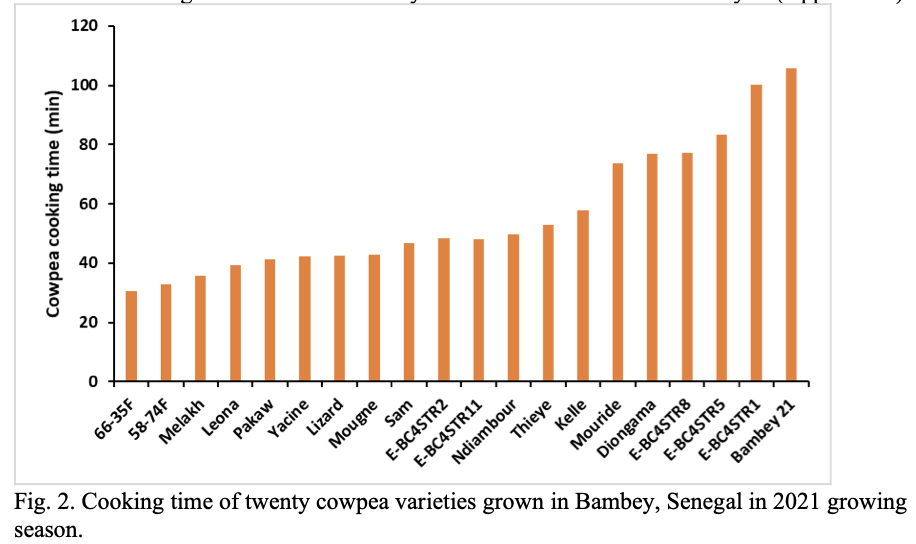
Calibrating equations to predict the nutritional quality of dual-purpose cowpea varieties using Near Infrared Spectroscopy: Using 120 dual-purpose cowpea forage samples from the 2021 variety trials, we developed Near Infrared Spectroscopy (NIRS) equations to estimate forage quality parameters including crude protein (CP), acid detergent fiber (ADF), neutral detergent fiber (NDF), calcium (Ca), phosphorus (P), potassium (K) and iron (Fe). Partial Least Squares (PLS) regression generated prediction equations using NIRS wavelength measurements and reference wet chemistry analysis from calibration samples were developed. The PLS prediction equations for the different forage quality parameters had R2 of calibration 0.94, 0.93, 0.88, 0.63, 0.69, 0.87, and 0.94 for CP, ADF, NDF, Ca, P, K, and Fe, respectively. Using these prediction equations, correlation of the predicted values of the calibration sub-set and prediction test subset resulted in significant positive relationships with R2 of 0.83, 0.74, 0.70, 0.63, 0.59, 0.75, and 0.83 for CP, ADF, NDF, Ca, P, K, and Fe, respectively (Fig.3). Corresponding RMSE of these relationships was 0.91, 2.68, 3.45, 0.23, 0.06, 0.11, and 100 for CP, ADF, NDF, Ca, P, K, and Fe, respectively (Fig. 3). The range and mean concentrations of the calibration subset overlapped that of the prediction subset for all parameters evaluated. Cross-validation procedures indicated good correlations between wet chemistry analysis and NIRS forage quality estimates. Link to the full paper https://www.mdpi.com/2071-1050/15/16/12155/pdf.
We used the NIRS calibration equations developed to predict cowpea forage quality of samples harvested from research plots in the 2021 and 2022 growing seasons. Example, forage quality 14 analysis from fodder samples in 2021 showed CP concentration ranged from 17% for cowpea varieties 66-35F and 58-74F to 12% for Mougne, E-BC4STR1, and E-BC4STR 8. The ADF and NDF concentrations were significantly less for 66-35F and 58-74F. These same varieties had the greatest fodder yields across environments. Forage CP, ADF and NDF concentrations of cowpea varieties Ndiambour, Mouride and Diogama, and Bambey21 were not different from new varieties Leona, Thieye or Kelle (Appendix 7).
Cowpea residue effects on millet yields: We evaluated prior cowpea residue management effect on grain and biomass yield of millet (Pennisetum glaucum (L.) R. Br) in rotation. Results showed cowpea fodder nutrient concentrations differed by variety, with 66-35F having the greatest nutrient concentration of 2.8- 0.45-0.82 % N-P-K. Applying fertilizer to previous cowpea crop increased millet grain yield by 63% compared to millet yield following previous non-fertilized cowpea plots. Furthermore, incorporation of cowpea residue prior to millet planting increased millet yield by 40% compared with the removal of cowpea biomass in 2020 but had no significant effect in 2021 (Fig. 4). The amount of cowpea biomass buried had a significant positive relationship with millet grain yield. Across years, millet grain yield increased by 0.16 kg/ha for each kg/ha increase in cowpea biomass buried prior to millet planting. Results showed a minimum of 1500 kg/ha buried cowpea residue was needed to increase probability of millet grain yield above 1000 kg/ha (Fig. 5). We concluded that the previous year’s cowpea residue burial and fertilizer management improved productivity of the rotational millet crop. Link to full research paper https://acsess.onlinelibrary.wiley.com/doi/10.1002/agg2.20413.
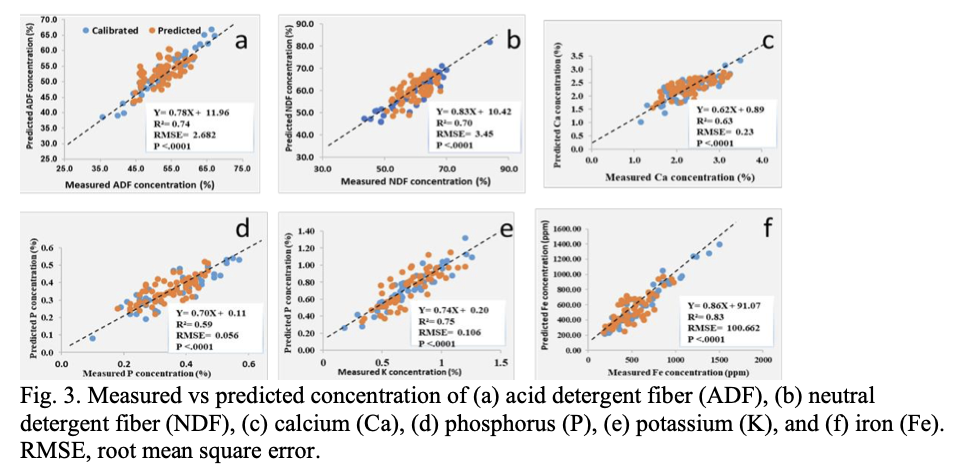

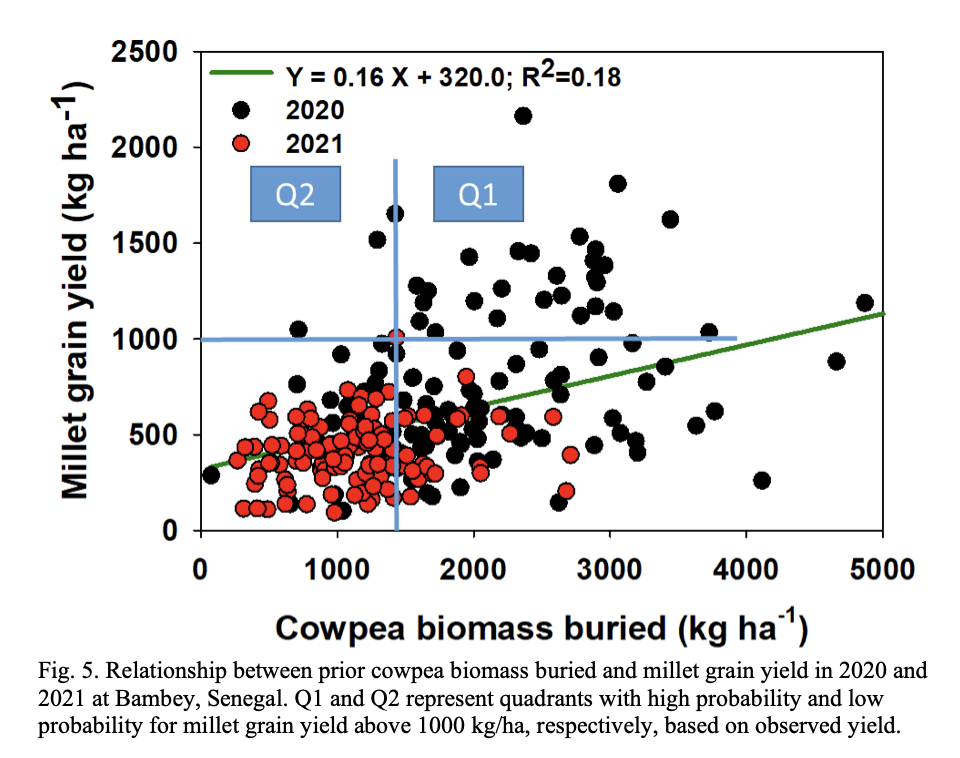
Objective 2: Conduct a tradeoff assessment for cowpea markets with particular focus on tradeoffs and synergies between grain and fodder production in areas that are traditionally pastoralists compared to areas that traditionally grow cowpea.
We showed from the baseline survey that most heads of households within the Senegalese peanut basin were middle-aged (52-54 years old), married (95-100%), illiterate (84%), and men (95- 100%). Households were mostly agriculture dependent (87%), low literacy rates (26% least primary school), with large family sizes.

Kebemer (Louga region), had the greatest planted acreage of cowpea, with an average production per household of 482 kg, while the average was 147 kg in Bambey and 125 kg in Kaffrine (Fig.6). The maximum household production was 800, 1000, and 9500 kg at Kaffrine, Bambey, and Kebemer, respectively (Table 1). The median cowpea yields across the study area varied from 35-100 kg/ha , well below the ~ 300-400 kg/ha average yields reported for Senegal and Sub-Saharan Africa.
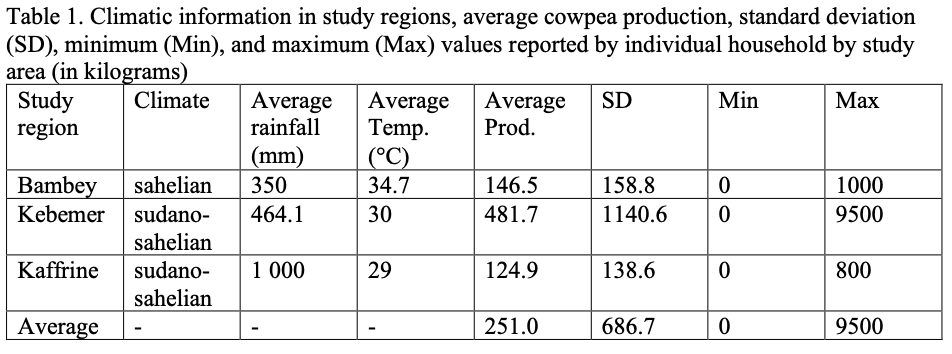
The proportion of farmers adopting new cowpea varieties was greatest in Bambey with 48% of households surveyed, 32% in Kaffrine, and 20% in Kebemer (Fig. 7). Access to improved varieties was generally explained by the presence of state or multi-national organizations sponsored research projects and programs in the region, this is particularly the case in Kaffrine. Farmer proximity to agricultural research or extension centers can also promote access to information on improved varieties. Most farmers (67%) in the study regions did not use improved varieties, and the main reasons were low seed availability (78.8%) and limited access to technical knowledge and information (76.3%), but only 5.8% indicated seed price as a barrier to improved variety adoption (Fig 7b). Uses of cowpea in the study area were for marketing, livestock feed, and human consumption. In Kaffrine, fodder production was the major criterion (85%) for cowpea variety selection, whereas in the north (Bambey and Kebemer), taste, maturity date, and grain yield were major selection criteria (Fig 7). Factors that had positive effect on the likelihood of using improved cowpea varieties include access to extension services, membership in farmers’ organization, cowpea being the main crop of production, farming practices, market, and livestock-oriented production systems, access to farmland and credit, dependence on agriculture as the main source of household income, and education of head of household.
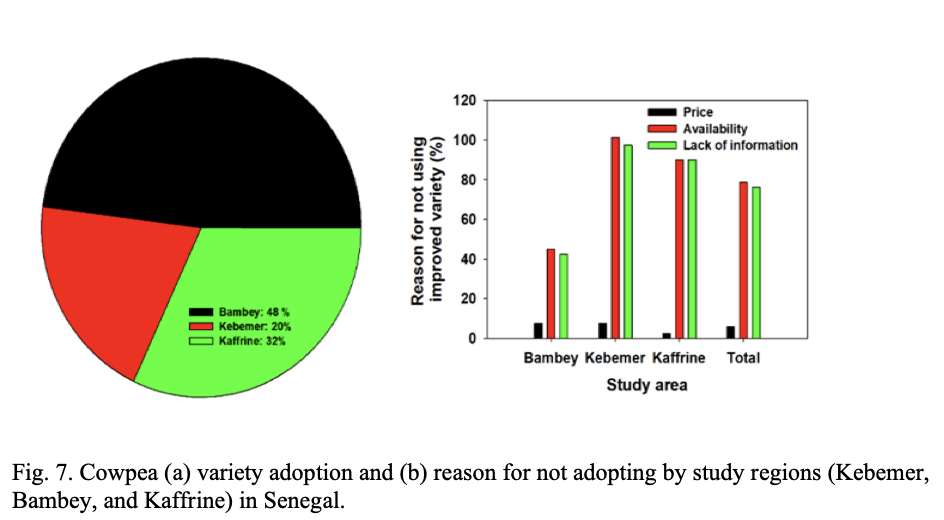
Final project survey results showed 70% of participants in the baby trial were men and 30% were women. The average age of heads of household was 50 years, with 25 years’ experience in cowpea production, married (92.6%), no formal education (81.1%) and can neither read nor write in any language (57.4%). The average number of fields farmed by project participants was 2.7 and was greater than non-beneficiaries (1.7). The average area of cowpea cultivated was 1 ha. However, fields devoted to project varieties were smaller and averaged (0.4 ha). Cowpea fields were acquired through inheritance (69.8%). Cowpea was grown in association with other crops, accounting for 51.9% of cowpea plots. Intercropping was only 34% of fields devoted to dual-purpose varieties, compared to 50% in the case of traditional varieties among beneficiaries of the project and 60.7% among non-beneficiaries. Row seeding was the most widely used method in cowpea plots at 76.3%. However, in plots planted with the project's varieties, transplanting in rows was the most common method, with 53.3% of plots. Manual weeding was the most common method used in cowpea plots (87.2%), which was used in 94.9% is fields devoted to dual-purpose varieties supplied by the project. Organic fertilizer was used in 40.4% of cowpea fields, particularly those using traditional varieties. However, 78.8% of dual-purpose variety fields used inorganic fertilizer. Among project beneficiaries, cowpea variety Thieye was commonly planted (50.4% of plots), followed by Leona (29.2%) and Yacine (20.4%). The average quantity of seed used in plots devoted to project varieties was smaller (1 kg) compared with 7.2 kg seeds of traditional varieties on beneficiary’s fields and 6.5 kg for non-beneficiaries. This was mainly because of limited seed availability. Cowpea grain yield on fields planted with project varieties averaged 455 kg/ha, which was 5-fold greater than those planted with traditional varieties on project beneficiary’s farms (81 kg/ha) and non-beneficiaries (94 kg/ha). The total yields of dual-purpose cowpeas varied, reaching a maximum of 6,000 kg/ha (total grain and fodder) in some locations. Average income from the sale of cowpeas in fields planted with traditional varieties averaged 84 815 FCFA for non-beneficiaries and 74 024 FCFA for beneficiaries, compared with 12 221 FCFA from plots planted with project varieties. The differences in revenue were due to the total area planted to cowpea.

Most beneficiary farmers (~70%) had taken part in field visits to the mother trials and had benefited from advisory support services over the last five years (55.6%). Farmers were satisfied with the advisory services received from the project (95.1%). This response was greater among beneficiaries, all of whom rated the advisory services they received as satisfactory (100%). Access to credit is relatively low among cowpea growers (14.4%), with project beneficiaries reported a higher access to credit (20%).
Tradeoff and impact analysis showed that 47% of producers have changed their production practices with introduction of dual-purpose cowpea, 3% had increased the amount of labor used, 23% of beneficiaries had increased their physical capital and 48% have cultivated new land (Appendix 8). Approximately 30% of beneficiaries indicated using dual-purpose varieties increased cowpea seed yields, and 58% indicated they had obtained more fodder yield (Appendix 9). Most beneficiaries (96%) did not directly use fodder for their livestock but rather sold to the fodder market to generate additional income.
Farmers showed a willingness to pay (WTP) for seed of the dual-purpose varieties tested in the study. Among beneficiaries, 95% of growers were willing to pay for the Leona and Thieye seed, 20 while 94% were willing to pay for Yacine seed. Among non-beneficiaries, the willingness to pay depends on knowledge of the varieties. Among beneficiaries, the maximum seed price offered was 5,000 FCFA/kg and minimum amount was 400 FCFA/kg. The average WTP seed price by farmers was greater for Thieye and Leona (1,334 FCFA/kg) compared to Yacine (1 248 FCFA/kg). Among non-beneficiaries, maximum WTP price for Leona and Thieye was 3,500 FCFA/kg and minimum were 500 FCFA/kg. For Yacine, the maximum and minimum WTP by non-beneficiaries were 3 000 FCFA/kg and 350 FCFA/kg, respectively. The average WTP prices by non-beneficiaries was greater for Thieye (1 437 FCFA/kg) compared to Leona (1 399 FCFA/kg) or Yacine (1 280 FCFA/kg).
According to farmers, the most appropriate communication channel for receiving information on dual-purpose varieties remains text message through cell phone. Social networks and radio are the other two preferred channels for receiving information about the new cowpea varieties. However, because of low patronage in farmer organizations, communication through farmer organizations was not preferred.
The overall project impacts assessment results showed a positive impact of dual-purpose cowpea varieties on grain and fodder yield. Notwithstanding, knowledge of dual-purpose varieties Leona and Thieye remains relatively low among non-beneficiaries (21% and 14% respectively). Dualpurpose cowpea varieties could increase beneficiaries' grain yields by 118 kg/ha. Additionally, dual-purpose cowpea varieties had a positive and significant impact on forage yield (~5,500 kg total fodder), an increase of 80% compared to traditional varieties. This resulted in a positive and significant impact on household well-being. The use of dual-purpose cowpea varieties could increase the per capita consumption expenditure of the producer's household by 12.1%. Most beneficiaries (81%) were satisfied with the dual-purpose varieties and 51% of beneficiaries indicated their standard of living has improved with the introduction of dual-use varieties (Appendix 8 c). The analysis of impact heterogeneity reveals that dual-purpose cowpea had greatest impact on residents in Darou Mousty. This finding is significant because this is the region with the largest cowpea production area and promotion programs that increase adoption of dual-purpose cowpea could improve livelihoods of smaller holder farmers in this region. Finally, we showed cowpea grain and fodder value chains that bring together a wide range of players involved in the various links. Cowpea seed was mostly supplied from farmer seed reserves, although government programs sometimes provided seeds. Cowpeas are harvested and marketed as green pods, dry seeds, and fodder. A significant proportion of the harvested grain is used for self-consumption, and the remaining sold at local or roadside markets. Women are in the majority in marketing and processing of cowpeas, and some maybe the heads of farming households responsible for production of cowpea. The distribution link is made up of intermediaries (men and women) in local markets, who are often retailers and buy directly from women producers and traders. Government agencies also support producers through subsidies for seeds, fertilizers, and phytosanitary products. However, we noticed that the cowpea value chain was not directly targeted by public policies. Consumers are in both rural and urban areas, including individual households and restaurants. The cowpea forage sub-chain comprises three links: production, marketing, and consumption. The main players are producers, traders (wholesalers and retailers) and breeders. Forage and dried pod are used to replace cattle feed. Smaller farmers used cowpea forage for feeding their own livestock while relatively larger farms produce cowpea forage mainly for sale. Fodder is distributed by traders and livestock breeders in urban markets, and by retailers in rural areas. Forage is sold in bags to wholesalers and retailers, and resold to breeders in bags, heaps, pots, or buckets, depending on the type of customer and 21 the sales environment. Exchanges between players often lead to price volatility on the market, especially during the lean season. The selling price of fodder varies from one period to another, with a profit margin of 500 FCFA. The minimum price was 1 500 FCFA after harvest and the maximum price was 3 000 FCFA in the lean season and can reach 5000 FCFA for ground fodder.
Highlights of Addressing Cross-Cutting Themes (HICD, Gender, Youth, Nutrition, Resilience)
Human and Intuitional Capacity Building:
Graduate student training: We were successful in training 4 graduate students in agronomy, 4 students in agricultural economics and rural sociology and one student on cowpea nutritional quality. Notably, Mr. Junior Bruno Papa Mbar Ndiaye, MS student working on the project was at Kansas State University Agricultural Research Center- Hays (from April through December 30, 2022) and trained in utilizing Near Infrared Spectroscopy (NIRS) for forage quality analysis. Mr. Ndiaye established calibration equations that can be used to predict forage nutritive value of dual-purpose cowpea samples harvested from the project. He also gained significant experience in dryland cropping system and soil management research with direct involvement in research activities in Dr. Obour’s Soil Management laboratory. The analytical and research skills gained over the 9-month exchange program at Kansas State University provided him skills in forage analysis and soil management expertise that would be useful in Senegal because of the limited capacity in forage analysis and cropping systems research.
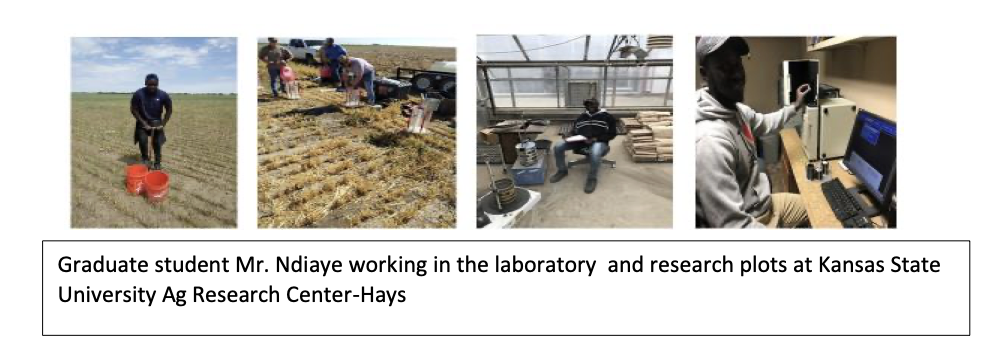
Scientific Exchanges: As part of this project, we collaborated with scientists working at the Institut Sénégalais de Recherches Agricoles (ISRA); Senegal National Agency for Extension and Advising (ANCAR), Feed the Future Sustainable Intensification Innovation Lab; Faculté des Sciences Economiques et de Gestion (FASEG), and Université Cheikh Anta Diop of Dakar. This allowed for scientific exchanges among individuals within the various intuitions. For example, Dr. Aliou Faye visited the Kansas State University Agricultural Research Center-Hays in April 2022 and May 20223 on a short scientific exchange program. This offered Dr. Faye the opportunity to learn about soil management and dryland cropping system research conducted on KSU experimental fields and producer farms across western Kansas. Despite the drought and Graduate student Mr. Ndiaye working in the laboratory and research plots at Kansas State University Ag Research Center-Hays 22 windy conditions, Dr. Faye was impressed about the level of soil cover across producer fields he visited whiles in Kansas, and this informed his decision to implement no-tillage experiments in Senegal. The lead PI, Dr. Obour visits to Senegal included interacting with farmers on their farms, seminar presentations, and assisting graduate students/researchers in field experiments design, revising data collection and analytical protocols, and summarizing data for publication in peer reviewed journals.
Gender and Youth: The on-farm baby trials provided an opportunity to directly engaged women farmers. Out of the 150 farmers who participated in testing dual-purpose cowpea varieties in the baby trials, 53 were women. In addition, over 93% of project participants were married suggesting that another 140 women were directly involved in the baby trials because women in the household are involved in cowpea production, and generally in charge of marketing and processing harvested cowpea grain. Also, the average number of women in households among project participants was 7, and everyone in the household was involved in farming, potentially adding 1050 women, directly or indirectly involved in dual-purpose cowpea project activities. Furthermore, over 40% of participants at on-farm field days organized in Darou Mousty and Boulel to showcase dual-purpose cowpea varieties were women
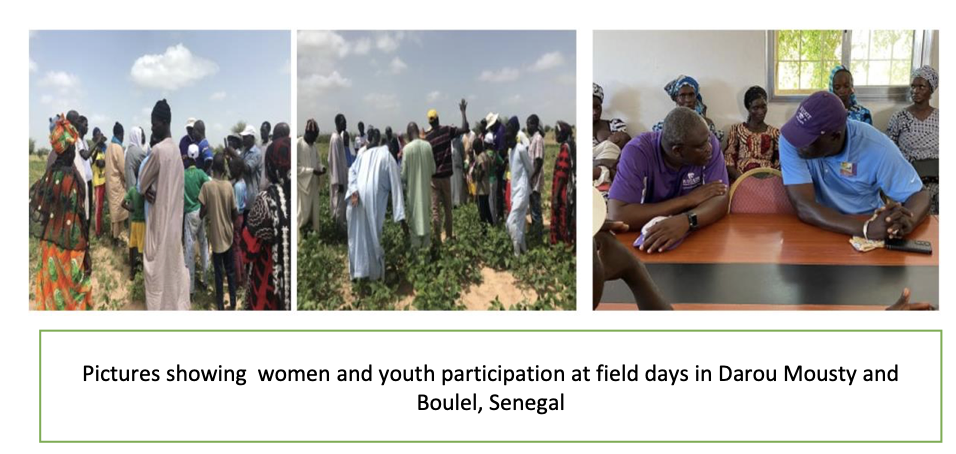
Youth: Youth engagement was integrated throughout project activities. First, the average age of farmers involved in the baby trial was 50, ranging from 18 to 75 years old. This suggests most of the on-farm study participants were younger. In addition, average number of children per household was 6, indicating a potential of >900 youth and children were directly involved in the project and learned about dual-purpose cowpeas. This was evident at project meetings and field days organized in October 2022. Furthermore, the project hired 20-30 high school students each growing season to help with planting, fertilizer application, weeding and harvesting of cowpeas at each project location. Furthermore, most of the participants (70%) at field days in Darou Mousty and Boulel, and seed production training organized in Bambey were between the ages of Pictures showing women and youth participation at field days in Darou Mousty and Boulel, Senegal 23 18 to 40 (youth). Finally, we engaged 10-15 undergraduate student enumerators to assist with baseline and final project survey for the socioeconomic analysis component of the project.
Nutrition and Resilience: We have conducted nutritional composition analysis comparing grain quality of the dual-purpose cowpea with the older variety Yacine. In general, grain protein and Fe concentrations were greater in the dual-purpose varieties compared to Yacine. However, the cooking time was not different. Forage quality was greater in the forage type varieties but forage quality parameters in the dual-purpose cowpea varieties were not different from the older variety Yacine. Notwithstanding, overall productivity and income from sales were greater with the dualpurpose cowpea varieties because of more fodder production (5-fold greater than Yacine across farms). Since most of the cowpea fodder was sold (96% of farmers) for additional income, 51% of participants in the baby-trials indicated improvements in their living standards by adopting dual-purpose cowpea varieties. This finding is significant and confirm our hypothesis that adopting dual-purpose cowpea varieties will improve food, nutritional and economic resilience of smallholder farmers in the Senegalese peanut basin.
Utilization of Research Outputs and Handoff/Scaling of the Outputs
Utilization of research Output
Findings and outputs from the project have been shared on several platforms including developing a factsheet on dual-purpose cowpea, entering demonstrating trials to showcase performance of dual-purpose cowpea varieties Thieye and Leona in the iREACH Technology Parks in Senegal, Ghana, and Burkina Faso. Results have also been shared through field days, workshops and granting interviews to local radio stations. Finally, results from the project were published in journal articles and presentations at international meetings, which are listed below:
Publications:
1) Ndiaye, J.B.; Obour, A.K.; Harmoney, K.; Diouf, D.; Faye, A.; Diamé, L.; Fall, D.; Assefa, Y. Predicting Nutritional Quality of Dual-Purpose Cowpea Using NIRS and the Impacts of Crop Management. Sustainability 2023, 15, 12155. https://doi.org/10.3390/ su15161215
2) Tine, S., Faye, A., Obour, A. K., Diouf, D., Ndiaye, J. B. M., Lo, M., Akplo, T. M., Ndiaye, S., & Assefa, Y. (2023). Cowpea residue management effect on productivity of subsequent millet in a legume-cereal crop rotation. Agrosystems, Geosciences & Environment, 6, e20413. https://doi.org/10.1002/agg2.20413.
3) Akplo, T. M., Faye, A., Obour, A., Stewart, Z. P., Min, D., & Prasad, P. V. V. (2023). Dual-purpose crops for grain and fodder to improve nutrition security in semi-arid subSaharan Africa: A review. Food and Energy Security, 00, e492. https://doi.org/10.1002/fes3.49.
4) Aliou Faye, Augustine Obour, Tobi Moriaque Akplo, Moussa Ndiagar, Ndiaga Cissé, Zachary Stewart, Vara Prasad. 2023. Performance of dual-purpose cowpea. Feed The Future iREACH Technology Brief, January 2023.
5) Beye, A.; P.B. Diakhate, O. Diouf, A. Faye, A. K. Obour, Z. P. Stewart, Y. Assefa, D. Min, and P. V. V. Prasad. 2022. Socio-economic constraints of adopting new cowpea varieties in three agro-ecological zones in the Senegalese peanut basin. Sustainability 14, 14550. https://doi.org/10.3390/ su142114550.
6) Ndiaye, J. B. P. M., Obour, A. K., Faye, A., Moriaque, A. T., Stewart, Z., Min, D., & Prasad, V. (2022) Improving Food and Nutrition Security through the Integration of Dual-Purpose Cowpea Varieties in the Agro-Pastoral Farming System in Senegal [Abstract]. ASA, CSSA, SSSA International Annual Meeting, Baltimore, MD. https://scisoc.confex.com/scisoc/2022am/meetingapp.cgi/Paper/141706.
7) Faye, A., Stewart, Z., Min, D., Obour, A. K., Manga, A. G., & Prasad, V. P. V. (2021) Agricultural innovation for boosting system productivity and resilience in sub Saharan Africa: Examples from West Africa [Abstract]. ASA, CSSA, SSSA International Annual Meeting, Salt Lake City, UT.
8) https://scisoc.confex.com/scisoc/2021am/meetingapp.cgi/Paper/133157.
9) Obour, A. K., Lo, M., Faye, A., Stewart, Z., Fall, D., Ndiangar, M., Sarr, I., Diallo, A. O., Min, D., & Prasad, V. P. V. (2021) Dual-purpose cowpea for grain and forage production in the senegalese peanut basin [Abstract]. ASA, CSSA, SSSA International Annual Meeting, Salt Lake City, UT. https://scisoc.confex.com/scisoc/2021am/meetingapp.cgi/Paper/137208.
10) Obour, A.K., A. Faye, A. Beye, Z. Stewart, D. Min, and P.V.V. Prasad. 2022. Adaptability of dual-purpose cowpea for grain and fodder production in semi-arid regions of West Africa. InterDrought 2022. The 7th Congress on Plant Production in WaterLimited Environment. Nov. 28 to Dec. 2, 2022. Dakar, Senegal. Abstract #7039.
11) Akplo, T. M., and A. Faye. 2022. Management practices for improved dual-purpose crops production in Senegal. Online Webinar. ISRA-CERAAS. March 10, 2022.
Handoff/Scaling of the Outputs
Our project has identified the best dual-purpose cowpea varieties for greater grain and fodder yields and best agronomic practice (eg. sowing date and density, fertilizer management) for the three cowpea agroecological zones. The on-farm baby-trial partnered directly with ~ 150 farmers across the 3 regions, allowed for direct farmer participation in testing and potential adoption of the dual-purpose cowpea varieties. Most of the farmers (96%) that participated in the project had indicated interest in adopting the dual-purpose cowpea technology on their farm. Example, Mr. Ousmane Mbacke a Muslim community leader who participated in the baby-trial in 2021 with less than 500 m2 plot, planted 8-hectares of dual-purpose cowpea in 2022 growing season on his farm near Darou Mousty. In fact, end of project survey results showed 48% of farmers that participated in the bay-trials have increased their farm size and 53% have changed their production practices since adopting dual-purpose cowpeas. However, the major limitation to large-scale adoption and increase in dual-purpose cowpea acreage is limited seed availability. This is consistent with results of socio-economic analysis conducted by our partner at the University Cheikh Anta Diop that showed low seed availability (78.8%) and limited access to technical information (76.3%) are the major barriers to dual-purpose cowpea variety adoption. We conducted a two-day seed production training at CERAAS for 30 participants including farmers and small private seed producers. This we hope can increase quality seed production and availability to farmers. We conducted two field days in Boulel and Darou Mousty to share results and technical information on dual-purpose cowpea to farmers. We also collaborated with iREACH to showcase dual-purpose cowpea innovation from this project in the Technology Parks in Senegal, Ghana, Burkina Faso, & Niger in 2022 and 2023 growing seasons. Including the dual-purpose cowpea at iREACH technology parks provides an avenue for scaling these new improved varieties to farmers and potential private sector agribusinesses beyond Senegal. For 25 example, through the ILLSR website, a Ghanaian citizen resident in USA requested dualpurpose cowpea seed showing interest in using our varieties to increase fodder availability for his livestock and possibly starting a seed production business in Ghana and Gambia. More importantly, the innovations (and technical information) developed in this project has been handoff to project partners at CERAAS, who will be collaborating with ANCAR in Senegal to develop scaling up activities beyond the project. There are a few smaller private seed companies (UNIS, SEDAB) and NGO (SYGNETA) dealing with seed multiplication and sales of cowpea varieties but the amounts they carry are usually not enough. Furthermore, to increase seed availability and increase adoption of these new cowpea varieties, we are working with scientists at CERAAS on developing a seed production program within ISRA/CERAAS that will produce seed of the dual-purpose cowpea varieties with farmer participation and collaborating with ANCAR to disseminate to farmers. Our research showed farmers within the study locations will be willing to pay seed costs if it is available. The Senegalese Ministry of Agriculture is on-board with this idea and are willing to provide initial funding support to start the seed production program and through the Food System Resilience Program funded by the World bank starting in September 2023. Dr. Faye and I are working on a proposal and procedures to get this dualpurpose seed production effort started. This effort was initiated in the 2023 growing season by multiplying seeds from these varieties at ISRA farm. This we believe will be a sustainable pathway for scaling and continuation of technology developed from this project. Finally, another important pathway of scaling our innovation is handing over project results to a recently funded World Bank project “Accelerating the impact of CGIAR research in Africa (AICCRA)” led in Senegal by co-PI Dr Faye who is working with agropastoralists and animal scientists to develop animal feeding ration using cowpea grain and fodder based in 4 other localities of Senegal (Meouen, Thiel , Daga Birame and Tambacounda).
Further Challenges and Opportunities
Seed availability: In general, seed availability is an issue for all the major crops grown in Senegal including cowpea, millet, and sorghum. Several farmers indicated they could not find seeds of the dual-purpose cowpea varieties at field days and producer meetings. This is a major challenge to adoption and scaling of improved cowpea varieties because our baseline survey results showed the barriers to adoption of dual-purpose cowpea varieties were low seed availability (78.8%) and limited access to technical knowledge and information (76.3%), but only 5.8% indicated seed costs was barrier to adoption. In our final project survey, most participants in the baby-trial indicated they are willing pay between 350 CFA to as much as 5000 CFA for seeds of dual-purpose cowpea variety Leona and Thieye. Similarly, a survey of farmers who did not participate in the baby-trials showed they are willing to pay 300 to 3500 CFA for seeds of dual-purpose cowpea varieties if available. This provides business opportunities for private or state sponsored seed production programs. A potential short-term solution is Senegalese government supporting ISRA/CERAAS to establish a foundation seed program to multiply selected seeds of the dual-purpose cowpea varieties and market this to producers. With the help of the extension services (ANCAR), seeds can be disseminated to farmers at a reduced cost to increase scaling up of the dual-purpose cowpea technology and generate revenue that can be invested in the cowpea breeding program in ISRA.
Limited Institutional Capacity: In general, there is little agronomic and cropping systems research within ISRA. Most research has focused on developing improved crop varieties with adaptation to biotic and abiotic stresses. We need more agronomists, for example there is no weed scientist in ISRA/CERAAS and weed pressure is a significant challenge that limits crop yields especially in years with adequate precipitation. In fact, I saw several millet, cowpea and peanut fields that were abandoned because of weeds in my visit to Senegal in October 2022. Capacity building in cropping systems and agronomy will accelerate the development of best management practices to improve yields of crop varieties. Furthermore, there is limited institutional capacity in forage, soil, and plant analysis in Senegal. When available, prices were cost prohibitive, or the laboratory was overwhelmed which resulted in delays in getting samples analyzed timely. In fact, grain and fodder samples from this project were shipped to the USA for analysis. Training and building institutional capacity (including laboratory facilities) to complete this analysis in country will be more efficient and cost effective.
Cropping/Systems level research: We observed most cowpea and other crops were grown in highly depleted soils with low soil fertility and little residue cover. Often, these fields are weedy, and farmers tend to abandon some of these fields in the growing season. A major contributing factor to the degraded soils is the lack of forage and crop residue removal as forage. Our research showed incorporating cowpea residue into the soil and applying fertilizer to previous cowpea increased grain and fodder yields of the next millet crop without fertilizer application. More cropping systems research are needed to fine tune crop residue management, soil health, varietal selection, improved crop rotations, weed management, and soil fertility to increase yields and reduce current yields gaps between potential yields of the improved varieties and actual yields obtained by farmers.
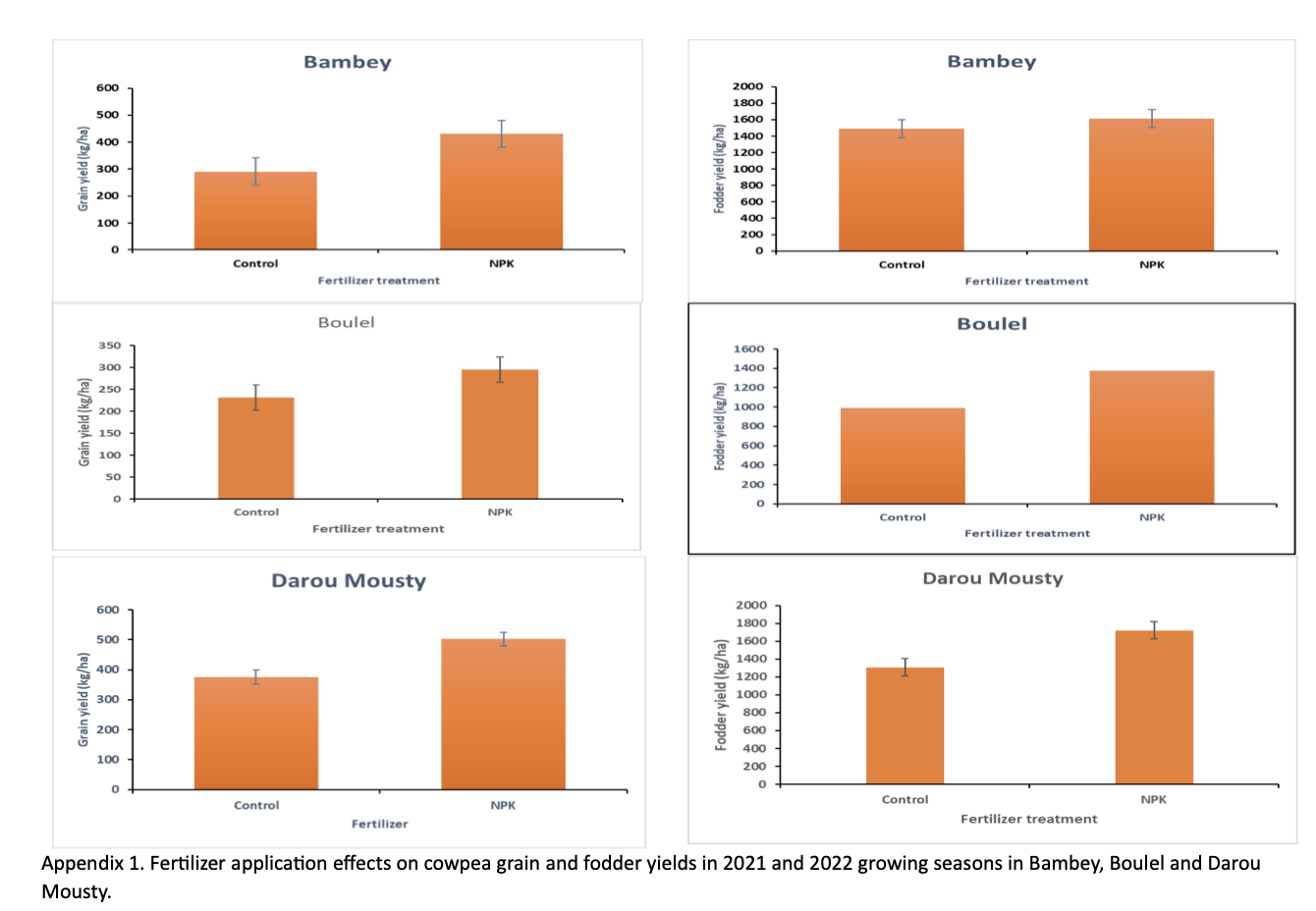
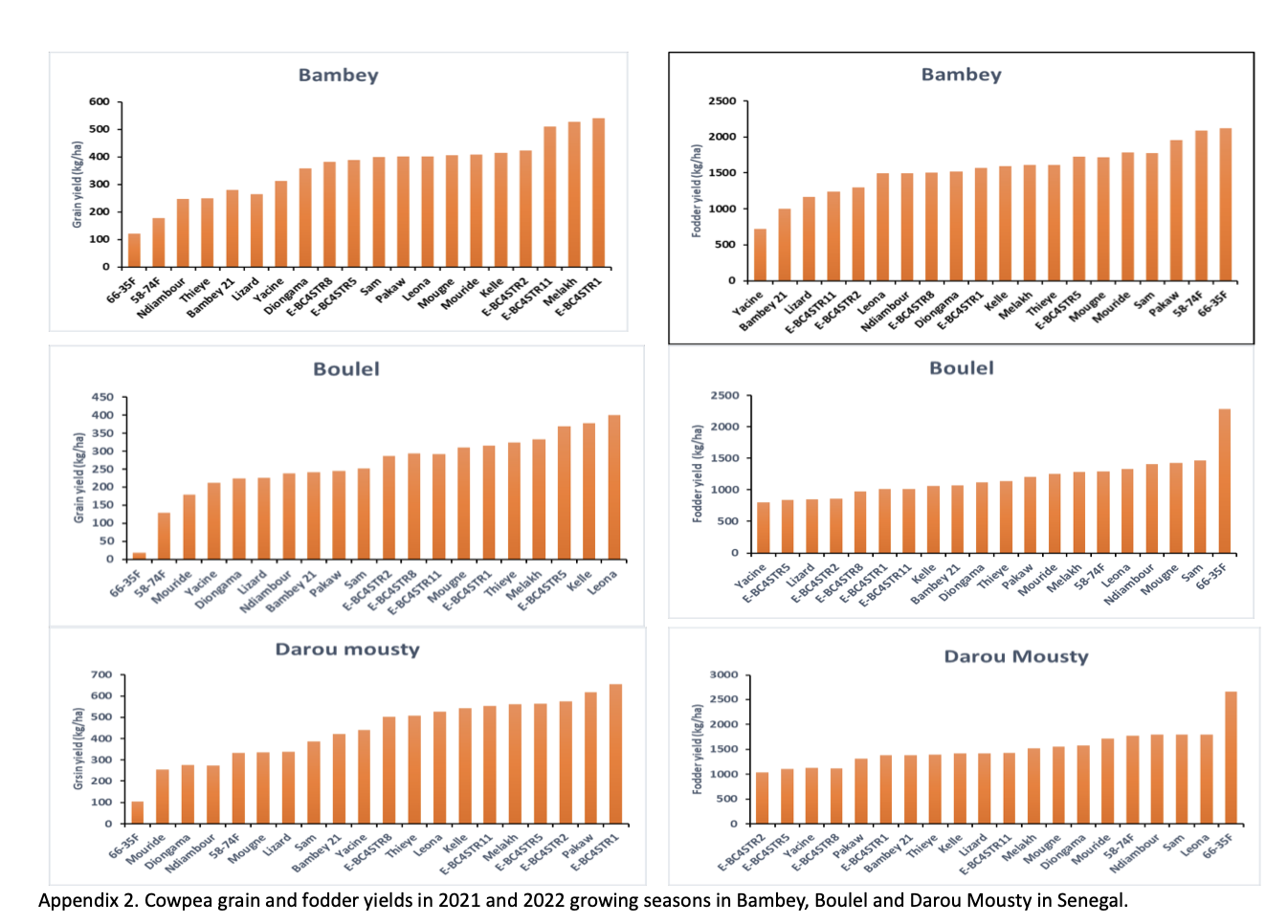

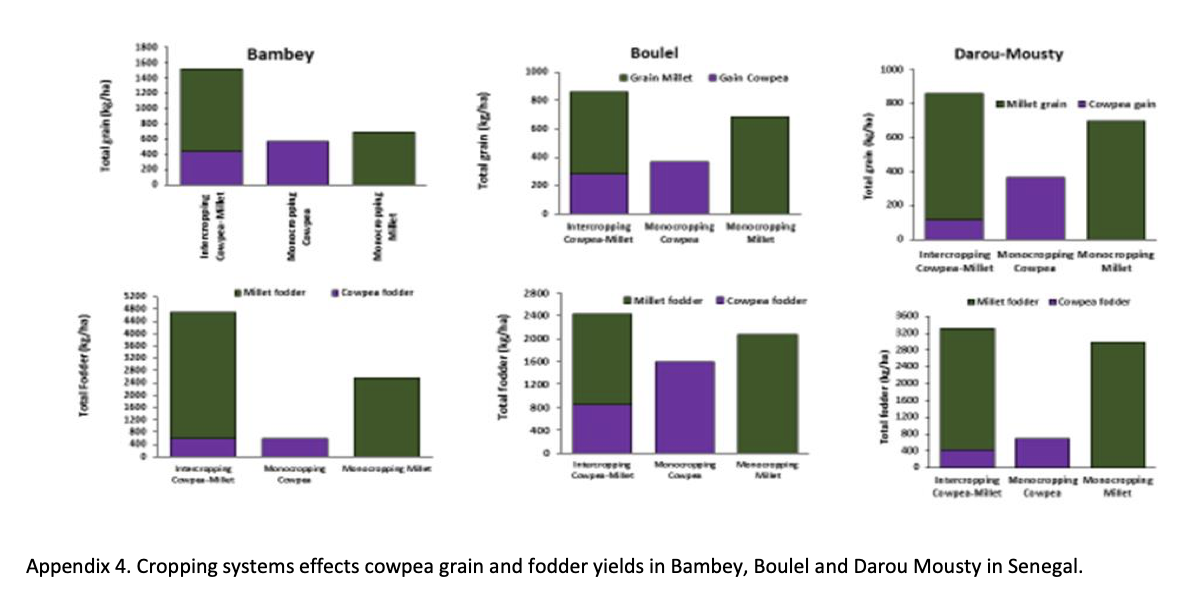
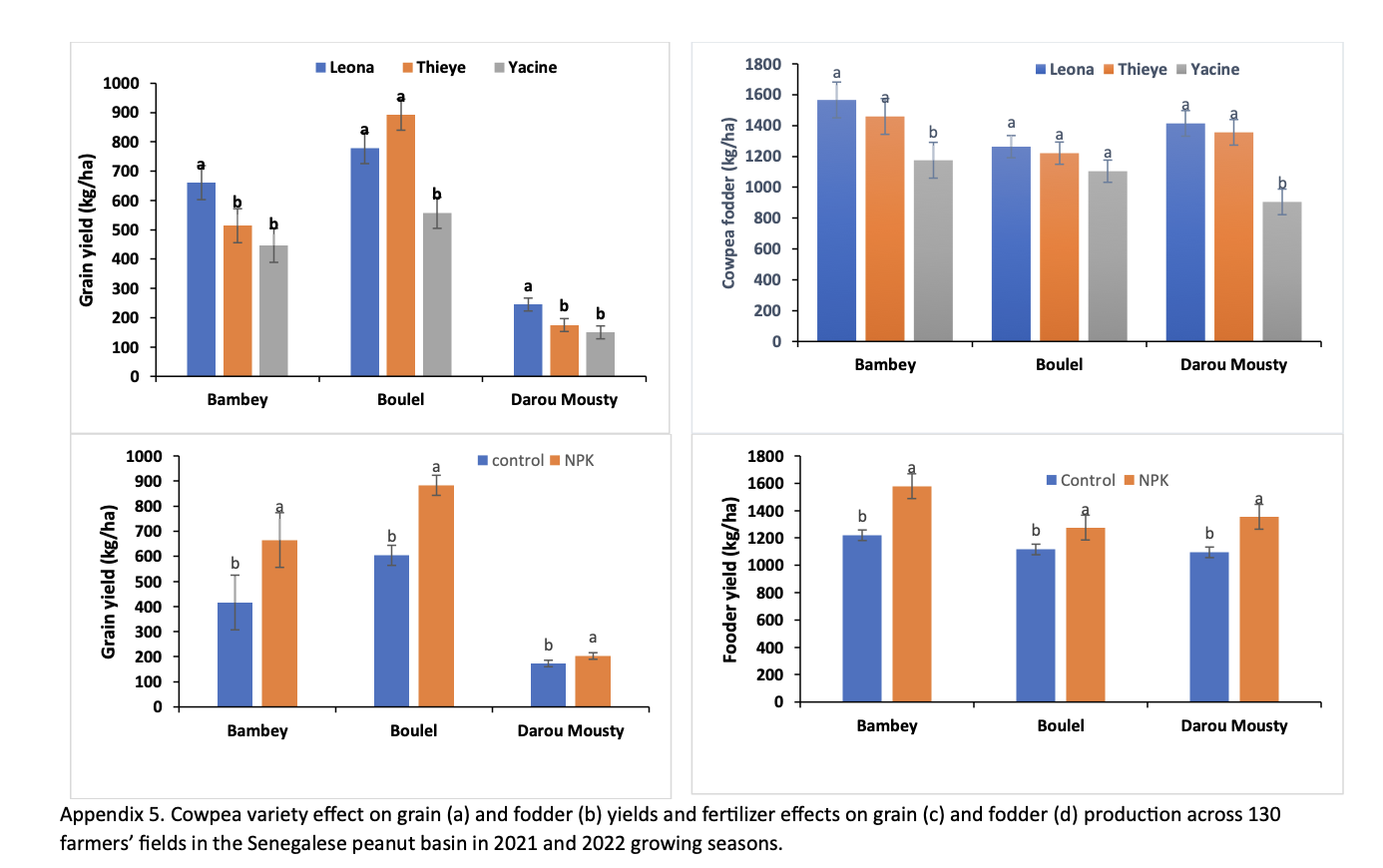
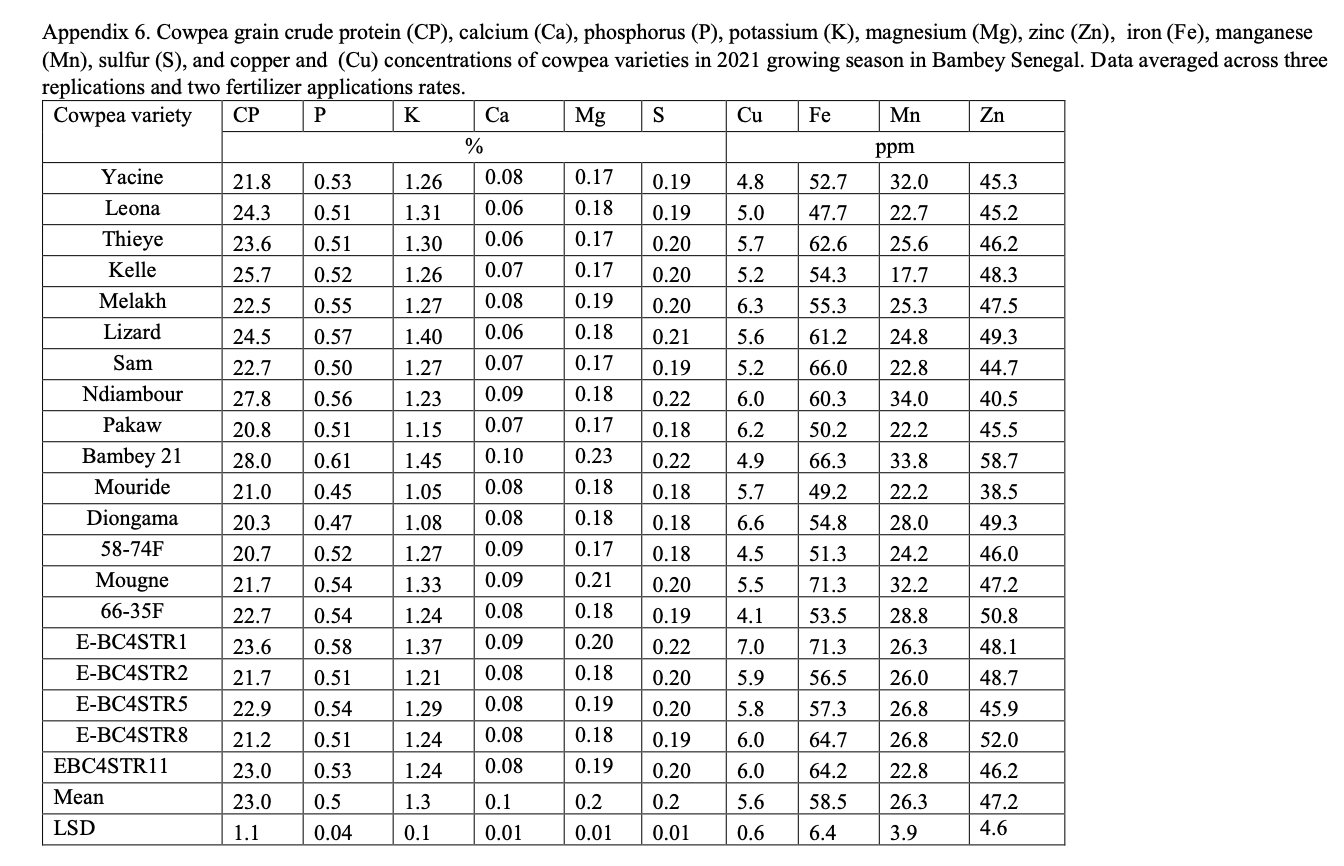
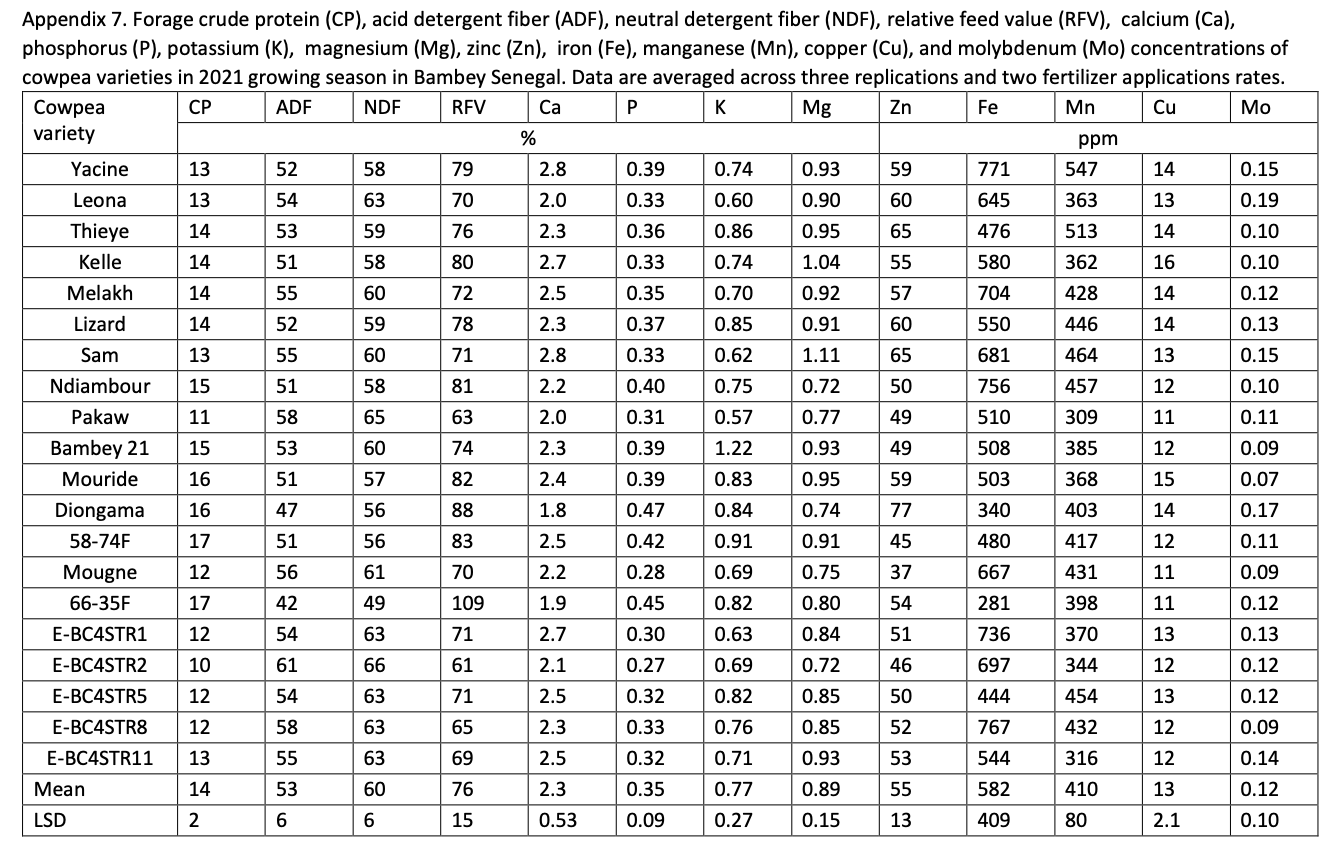
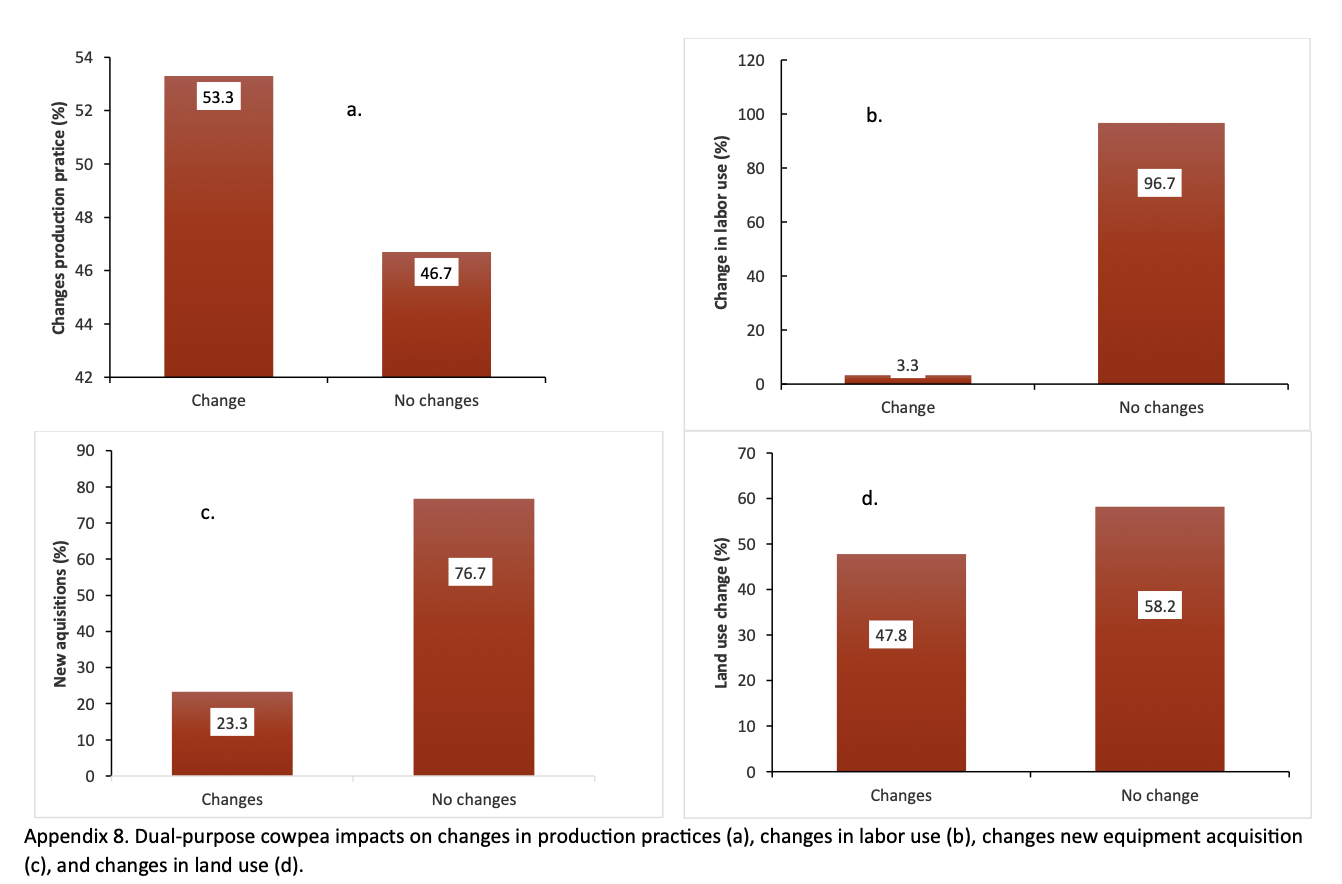
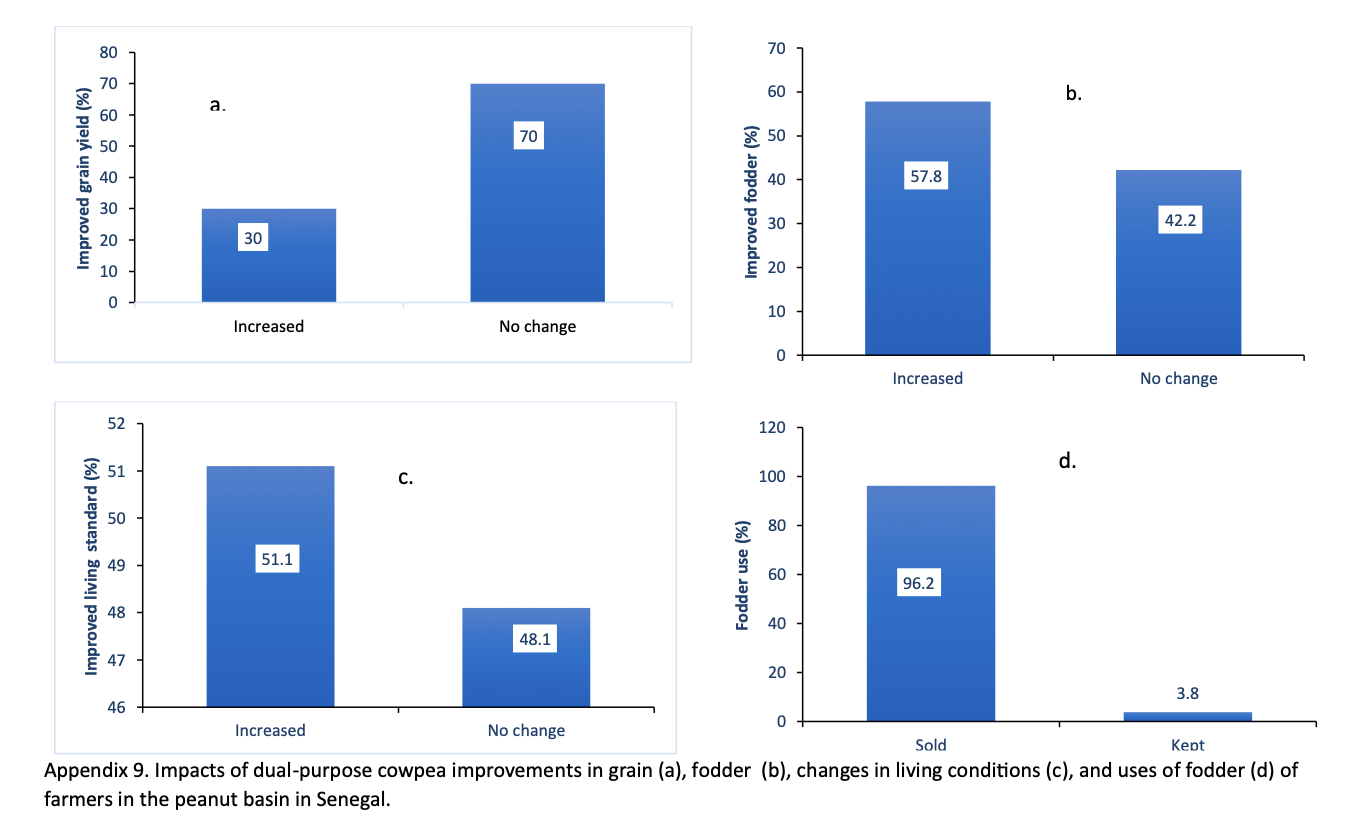



 Print
Print Email
Email